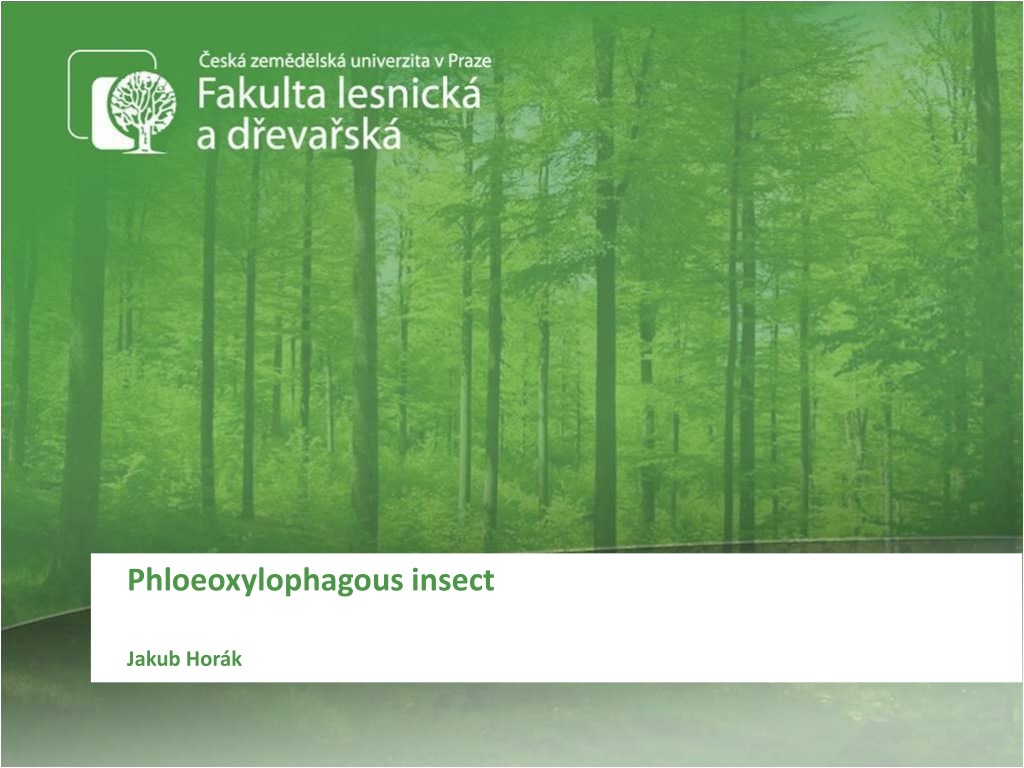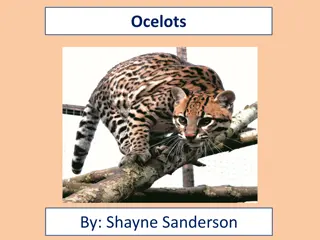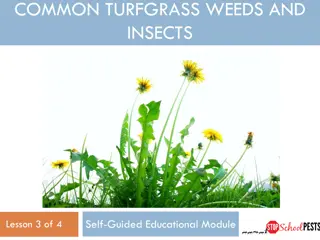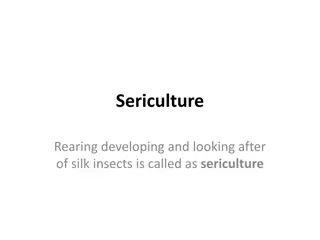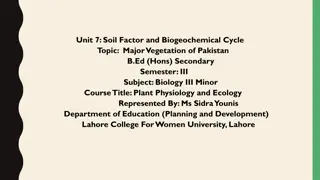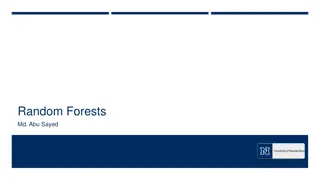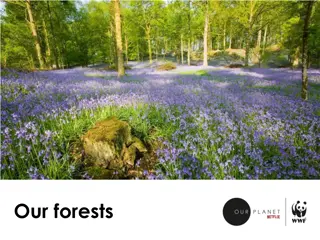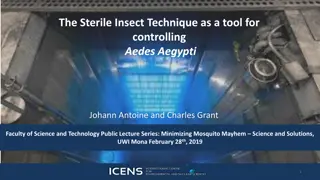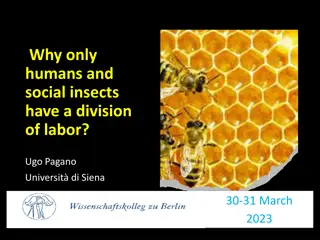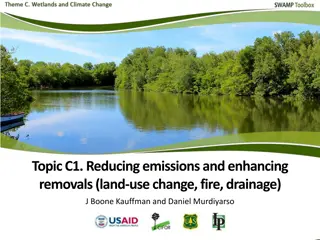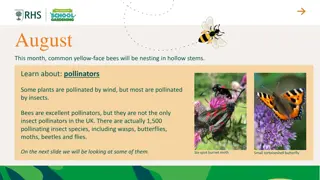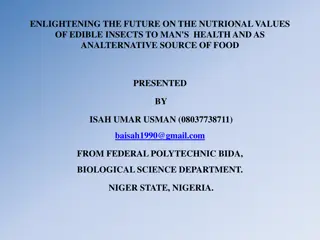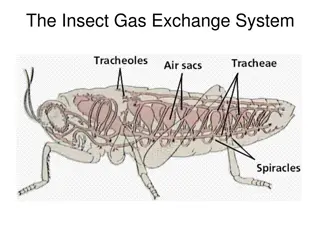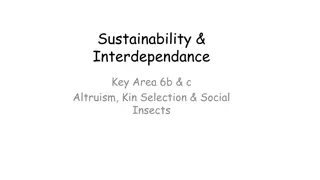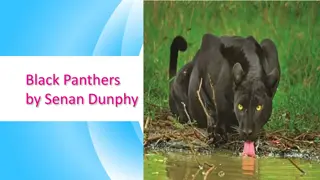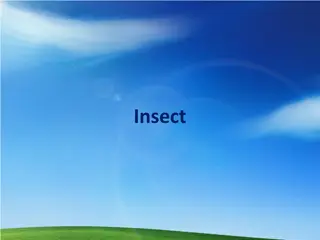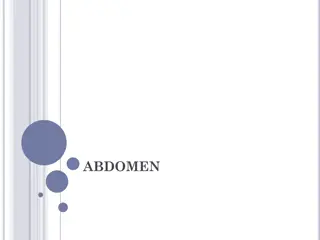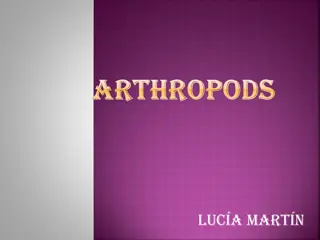Understanding Phloeoxylophagous Insects and Their Impact on Forests
Phloeoxylophagous insects, such as bark and ambrosia beetles, play a significant role in forestry as wood-boring organisms. This group primarily consists of beetles, hymenopterans, and flies, with beetles being the most prevalent. The last generation of Ips typographus, a bark beetle, undergoes a crucial phase where immature adults ready themselves for overwintering. Bark beetle outbreaks can have substantial consequences on forest ecosystems.
Download Presentation

Please find below an Image/Link to download the presentation.
The content on the website is provided AS IS for your information and personal use only. It may not be sold, licensed, or shared on other websites without obtaining consent from the author. Download presentation by click this link. If you encounter any issues during the download, it is possible that the publisher has removed the file from their server.
E N D
Presentation Transcript
Phloeoxylophagous insect Jakub Hor k
Phloeoxylophagous insect Jakub Hor k www.forestry.gov.uk Introduction The group of phloeophagous and wood- boring organisms is mainly consisted of insect taxa.
Phloeoxylophagous insect Jakub Hor k www.forestry.gov.uk Introduction The group of phloeophagous and wood-boring organisms is mainly consisted of insect taxa. Beetles (Coleoptera), hymenopterans (Hymenoptera) or flies (Diptera).
Phloeoxylophagous insect Jakub Hor k www.forestry.gov.uk Introduction The group of phloeophagous and wood-boring organisms is mainly consisted of insect taxa. Beetles (Coleoptera), hymenopterans (Hymenoptera) or flies (Diptera). Beetles appear to be the most important taxonomic groups.
Phloeoxylophagous insect Jakub Hor k www.forestry.gov.uk Introduction The group of phloeophagous and wood-boring organisms is mainly consisted of insect taxa. Beetles (Coleoptera), hymenopterans (Hymenoptera) or flies (Diptera). Beetles appear to be the most important taxonomic groups. Phloeoxylophagous insects and especially bark and ambrosia beetles (Scolytinae and Platypodinae) belong to one of the highly studied topics.
Phloeoxylophagous insect Jakub Hor k Last generation of the year of Ips typographus
Phloeoxylophagous insect Jakub Hor k Last generation of the year of Ips typographus Callow (i.e. immature) adults are mostly at the end of former larval galleries.
Phloeoxylophagous insect Jakub Hor k Last generation of the year of Ips typographus Callow (i.e. immature) adults are mostly at the end of former larval galleries. Part of them will overwinter under the bark, while majority will emerge and overwinter in forest soil.
Phloeoxylophagous insect Jakub Hor k Bark beetle outbreaks
Phloeoxylophagous insect Jakub Hor k Bark beetle outbreaks Risk-rating models for damages caused by bark beetle.
Phloeoxylophagous insect Jakub Hor k Bark beetle outbreaks Risk-rating models for damages caused by bark beetle. In temperate part of Sweden and used predictors like wood volume of Norway spruce and Birch per hectare, mean tree height, distance to the clear cuts, presence of bark beetle infestation spots and number of infestation spots in the neighborhood.
Phloeoxylophagous insect Jakub Hor k Bark beetle outbreaks Risk-rating models for damages caused by this bark beetle. In temperate part of Sweden and used predictors like wood volume of Norway spruce and Birch per hectare, mean tree height, distance to the clear cuts, presence of bark beetle infestation spots and number of infestation spots in the neighborhood. Found that increasing volume of the Norway spruce was the only one significant predictor that positively influenced relative risks of infestation by the Spruce bark beetle.
Phloeoxylophagous insect Jakub Hor k Bark beetle outbreaks Risk-rating models for damages caused by this bark beetle. In temperate part of Sweden and used predictors like wood volume of Norway spruce and Birch per hectare, mean tree height, distance to the clear cuts, presence of bark beetle infestation spots and number of infestation spots in the neighborhood. Found that increasing volume of the Norway spruce was the only one significant predictor that positively influenced relative risks of infestation by the spruce bark beetle. Also found that the trees killed by the spruce bark beetle in managed forest landscapes are distributed in many small infestation spots.
Phloeoxylophagous insect Jakub Hor k Bark beetle control
Phloeoxylophagous insect Jakub Hor k Bark beetle control Difference between pheromone baited traps and pheromone baited tripods that are treated by insecticide.
Phloeoxylophagous insect Jakub Hor k Bark beetle control Difference between pheromone baited traps and pheromone baited tripods that are treated by insecticide. Commonly used pheromone traps were more efficient in captures of the bark beetle.
Phloeoxylophagous insect Jakub Hor k Bark beetle control Difference between pheromone baited traps and pheromone baited tripods that are treated by insecticide. Found that commonly used pheromone traps were nearly three times more efficient in captures of the double-spined bark beetle. Pheromone traps captured more females than males, while tripods lured and killed males and females in the same ratio.
Phloeoxylophagous insect Jakub Hor k Bark beetle control Difference between pheromone baited traps and pheromone baited tripods that are treated by insecticide. Found that commonly used pheromone traps were nearly three times more efficient in captures of the double-spined bark beetle. Pheromone traps captured more females than males, while tripods lured and killed males and females in the same ratio. Both types of traps were more efficient during spring months than in summer.
Phloeoxylophagous insect Jakub Hor k Bark beetle control Difference between pheromone baited traps and pheromone baited tripods that are treated by insecticide. Found that commonly used pheromone traps were nearly three times more efficient in captures of the double-spined bark beetle. Pheromone traps captured more females than males, while tripods lured and killed males and females in the same ratio. Both types of traps were more efficient during spring months than in summer. Tripods killed significantly higher number of beneficial and non-target insects than pheromone traps.
Phloeoxylophagous insect Jakub Hor k Bark beetle control Difference between pheromone baited traps and pheromone baited tripods that are treated by insecticide. Found that commonly used pheromone traps were nearly three times more efficient in captures of the double-spined bark beetle. Pheromone traps captured more females than males, while tripods lured and killed males and females in the same ratio. Both types of traps were more efficient during spring months than in summer. Tripods killed significantly higher number of beneficial and non- target insects than pheromone traps. The use of tripods thus should be omitted in forest protection.
Phloeoxylophagous insect Jakub Hor k Fertilization effect
Phloeoxylophagous insect Jakub Hor k Fertilization effect Damages caused by the Pine weevil in Maritime pine (Pinus pinaster) plantations in Spain.
Phloeoxylophagous insect Jakub Hor k Fertilization effect Damages caused by the Pine weevil in Maritime pine (Pinus pinaster) plantations in Spain. Found that fertilization (combinations of ammonium nitrate, calcium phosphate, potassium sulphate and magnesium sulphate) had a strong and significant effect on pine weevil damage.
Phloeoxylophagous insect Jakub Hor k Fertilization effect Damages caused by the Pine weevil in Maritime pine (Pinus pinaster) plantations in Spain. Found that fertilization (combinations of ammonium nitrate, calcium phosphate, potassium sulphate and magnesium sulphate) had a strong and significant effect on pine weevil damage. The damage by the pine weevil was greater on fertilized plants.
Phloeoxylophagous insect Jakub Hor k Fertilization effect Damages caused by the Pine weevil in Maritime pine (Pinus pinaster) plantations in Spain. Found that fertilization (combinations of ammonium nitrate, calcium phosphate, potassium sulphate and magnesium sulphate) had a strong and significant effect on pine weevil damage. The damage by the pine weevil was greater on fertilized plants. The loss on seedlings against unfertilized control was nearly four times higher.
Phloeoxylophagous insect Jakub Hor k Fertilization effect Damages caused by the Pine weevil in Maritime pine (Pinus pinaster) plantations in Spain. Found that fertilization (combinations of ammonium nitrate, calcium phosphate, potassium sulphate and magnesium sulphate) had a strong and significant effect on pine weevil damage. The damage by the pine weevil was greater on fertilized plants. The loss on seedlings against unfertilized control was nearly four times higher. No significant effect of fertilization on growth of seedling of Maritime Pine was observed.
Phloeoxylophagous insect Jakub Hor k Bark beetle as a keystone?
Phloeoxylophagous insect Jakub Hor k Bark beetle as a keystone? Bark beetle in Germany.
Phloeoxylophagous insect Jakub Hor k Bark beetle as a keystone? Bark beetle in Germany. Compared undisturbed forest stands, gaps created by man and gaps created by spruce bark beetle.
Phloeoxylophagous insect Jakub Hor k Bark beetle as a keystone? Bark beetle in Germany. Compared undisturbed forest stands, gaps created by man and gaps created by spruce bark beetle. Species richness of three studied taxa bugs (Heteroptera), bees and wasps (Hymenoptera) and saproxylic beetles (Coleoptera) was higher in gaps than in forests.
Phloeoxylophagous insect Jakub Hor k Bark beetle as a keystone? Bark beetle in Germany. Compared undisturbed forest stands, gaps created by man and gaps created by spruce bark beetle. Species richness of three studied taxa bugs (Heteroptera), bees and wasps (Hymenoptera) and saproxylic beetles (Coleoptera) was higher in gaps than in forests. Saproxylic beetles were more species rich in gaps created by bark beetle and the same result was reached for threatened species.
Phloeoxylophagous insect Jakub Hor k Bark beetle as a keystone? Bark beetle in Germany. Compared undisturbed forest stands, gaps created by man and gaps created by spruce bark beetle. Species richness of three studied taxa bugs (Heteroptera), bees and wasps (Hymenoptera) and saproxylic beetles (Coleoptera) was higher in gaps than in forests. Saproxylic beetles were more species rich in gaps created by bark beetle and the same result was reached for threatened species. Concluded that that Ips typographus fulfils the majority of criteria for a keystone species, particularly those that help to maintenance of biodiversity in forests.
Phloeoxylophagous insect Jakub Hor k Bark beetle as a keystone? Bark beetle in Germany. Compared undisturbed forest stands, gaps created by man and gaps created by spruce bark beetle. Species richness of three studied taxa bugs (Heteroptera), bees and wasps (Hymenoptera) and saproxylic beetles (Coleoptera) was higher in gaps than in forests. Saproxylic beetles were more species rich in gaps created by bark beetle and the same result was reached for threatened species. Concluded that that Ips typographus fulfils the majority of criteria for a keystone species, particularly those that help to maintenance of biodiversity in forests. Nevertheless, the potential risk of damages by this beetle could be hardy accepted in spruce plantations.
Phloeoxylophagous insect Jakub Hor k Bark beetles and exotic trees
Phloeoxylophagous insect Jakub Hor k Bark beetles and exotic trees Colonization of three native conifers and five above north-American conifers by native bark beetles.
Phloeoxylophagous insect Jakub Hor k Bark beetles and exotic trees Colonization of three native conifers and five above north-American conifers by native bark beetles. Done in France.
Phloeoxylophagous insect Jakub Hor k Bark beetles and exotic trees Colonization of three native conifers and five above north-American conifers by native bark beetles. Done in France. Collected eighteen indigenous and, furthermore, two exotic bark beetles.
Phloeoxylophagous insect Jakub Hor k Bark beetles and exotic trees Colonization of three native conifers and five above north-American conifers by native bark beetles. Done in France. Collected eighteen indigenous and, furthermore, two exotic bark beetles. All exotic conifer species were colonized by indigenous bark beetles and no significant difference was observed between native and exotic tree species.
Phloeoxylophagous insect Jakub Hor k Bark beetles and exotic trees Colonization of three native conifers and five above north- American conifers by native bark beetles. Done in France. Collected eighteen indigenous and, furthermore, two exotic bark beetles. All exotic conifer species were colonized by indigenous bark beetles and no significant difference was observed between native and exotic tree species. Found that the ability of indigenous bark beetles to shift onto exotic conifers depend on host tree species, the presence of phylogenetically related native conifers and that of similar resources, in combination with insect host specificity.
Phloeoxylophagous insect Jakub Hor k Bark beetles and exotic trees Colonization of three native conifers and five above north-American conifers by native bark beetles. Done in France. Collected eighteen indigenous and, furthermore, two exotic bark beetles. All exotic conifer species were colonized by indigenous bark beetles and no significant difference was observed between native and exotic tree species. Found that the ability of indigenous bark beetles to shift onto exotic conifers depend on host tree species, the presence of phylogenetically related native conifers and that of similar resources, in combination with insect host specificity. Conclusion is that trees are under the treat by bark beetles also in non-native areas.
Phloeoxylophagous insect Jakub Hor k Bark beetles and symbiosis effect
Phloeoxylophagous insect Jakub Hor k Bark beetles and symbiosis effect Influence of nitrogen in food on development of bark beetles with and without symbiotic fungi.
Phloeoxylophagous insect Jakub Hor k Bark beetles and symbiosis effect Influence of nitrogen in food on development of bark beetles with and without symbiotic fungi. Loblolly pine (Pinus taeda) as a host tree.
Phloeoxylophagous insect Jakub Hor k Bark beetles and symbiosis effect Influence of nitrogen in food on development of bark beetles with and without symbiotic fungi. Loblolly pine (Pinus taeda) as a host tree. The southern pine beetle (Dendroctonus frontalis) with symbiotic fungi and eastern five-spined bark beetle (Ips grandicollis) without symbionts.
Phloeoxylophagous insect Jakub Hor k Bark beetles and symbiosis effect Influence of nitrogen in food on development of bark beetles with and without symbiotic fungi. Loblolly pine (Pinus taeda) as a host tree. The southern pine beetle (Dendroctonus frontalis) with symbiotic fungi and eastern five-spined bark beetle (Ips grandicollis) without symbionts. Phloem (bast) is very low in content of nitrogen too and often contains poisonous substances.
Phloeoxylophagous insect Jakub Hor k Bark beetles and symbiosis effect Influence of nitrogen in food on development of bark beetles with and without symbiotic fungi. Loblolly pine (Pinus taeda) as a host tree. The southern pine beetle (Dendroctonus frontalis) with symbiotic fungi and eastern five-spined bark beetle (Ips grandicollis) without symbionts. Phloem (bast) is very low in content of nitrogen too and often contains poisonous substances. Mycangial fungi provide their benefits by concentrating dietary nitrogen for larvae.
Phloeoxylophagous insect Jakub Hor k Bark beetles and symbiosis effect Influence of nitrogen in food on development of bark beetles with and without symbiotic fungi. Loblolly pine (Pinus taeda) as a host tree. The southern pine beetle (Dendroctonus frontalis) with symbiotic fungi and eastern five-spined bark beetle (Ips grandicollis) without symbionts. Phloem (bast) is very low in content of nitrogen too and often contains poisonous substances. Mycangial fungi provide their benefits by concentrating dietary nitrogen for larvae. Trees with higher nitrogen content produced larger southern pine beetle adults.
Phloeoxylophagous insect Jakub Hor k Bark beetles and symbiosis effect Influence of nitrogen in food on development of bark beetles with and without symbiotic fungi. Loblolly pine (Pinus taeda) as a host tree. The southern pine beetle (Dendroctonus frontalis) with symbiotic fungi and eastern five-spined bark beetle (Ips grandicollis) without symbionts. Phloem (bast) is very low in content of nitrogen too and often contains poisonous substances. Mycangial fungi provide their benefits by concentrating dietary nitrogen for larvae. Trees with higher nitrogen content produced larger southern pine beetle adults. Non-mycangial bark beetles meet their nitrogen budgets through high consumption of unaltered phloem with low content of nitrogen.
Phloeoxylophagous insect Jakub Hor k Defense against bark beetles
Phloeoxylophagous insect Jakub Hor k Defense against bark beetles Studied in Canada potential factors in resistance of Lodgepole pine to the bark beetle attack.
